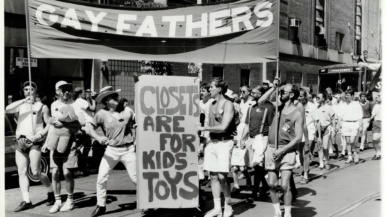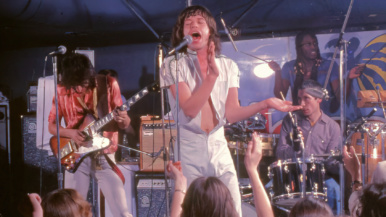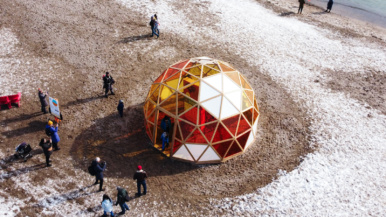The fascinating stories behind the Hanlan’s Point hotel, High Park mineral baths and seven other lost Toronto landmarks

Doug Taylor, a 79-year-old retired teacher and historian, has watched Toronto drastically change. In 1959, he witnessed the opening of the St. Lawrence Seaway, which allowed ocean freighters to bypass Montreal and access major U.S. markets via Toronto, sparking an economic boom and, with it, newer and bigger buildings. Entire neighbourhoods vanished. “We’ve lost the feel of the city,” says Taylor.
Taylor tries to recapture it in his new book, Lost Toronto, a catalogue of iconic buildings and landmarks that have come and gone. He delved into the Ontario and Toronto archives as well as his own personal collection of tens of thousands of photographs, which date back to 1890. (He’s amassed them while working on his blog Historic Toronto and other books, like a tome dedicated to Toronto’s old movie theatres). We asked Taylor for the stories behind our favourite photos from Lost Toronto.

Palace of Industry
Opened in 1858 • Burned down in 1906
The Palace of Industry, commonly referred to as Crystal Palace, was a 25,000-square-foot building that hosted agricultural exhibitions at King and Shaw. It was dismantled and moved to Exhibition Place (where the now-shuttered Muzik nightclub now stands) as the highlight of the 1879 Industrial Exhibition, which was renamed the Canadian National Exhibition in 1912. The building, made entirely of plate glass and cast-iron framing, was destroyed in a fire in 1906.

Hotel Hanlan
Opened 1878 • Burned down in 1909
Irish immigrant John Hanlan was a police constable who patrolled Toronto Islands’ beaches and parks. He built himself a house on West Point—now called Hanlan’s Point in his honour—and converted it into a hotel in 1878. John’s son Ned rowed from the Islands to school on the mainland every day, and eventually won the world championship for rowing, the first Canadian athlete to attain an international sporting honour. Ned eventually took over his father’s business and built a new three-storey hotel near its original site. Another owner later added a fourth floor, carousel and opera house, and it became a popular holiday destination. The hotel burned down in a fire that ravaged Hanlan’s Point in 1909.

Robert Simpson Company
Opened in 1894 • Sold in 1978
Scottish immigrant Robert Simpson opened his store in 1872 and moved it to the iconic Yonge and Queen location nine years later. He built a six-storey department store at the intersection in 1894, but it burned down within a year. The structure he replaced it with was the first fire-proof building in Canada, with its columns and beams encased in concrete. People from across the country visited to shop, ride its elevators (another big innovation) and attend special events, including King George VI’s royal visit in 1939. It was also a popular spot during Queen Elizabeth II’s coronation in 1953. “Everybody, including my family, rushed to get a TV set to watch the coronation,” says Taylor. “Traffic couldn’t move for two weeks because of all the people who went to Simpson’s and the stores along Yonge.” The Hudson’s Bay Company bought the store in 1978.

S.S. Cayuga
Launched in 1906 • Scrapped in 1960
“For many families, no summer was complete without a trip on the Cayuga,” says Taylor. The 1,900-passenger ship, which docked at the foot of York Street, made day trips across the lake to Port Dalhousie for picnics—a popular cruise given cars were a rarity immediately after WWII, when gasoline and tires were still rationed. “In those days, there would be only one family on most streets that had a car, and when it went up the street you stopped for a minute and took a look,” says Taylor. The Cayuga (named after an Iroquois tribe) carried a total of 15 million passengers between day trips, midnight cruises, and church and corporate events; it also shipped Niagara produce to Toronto. As rationing eased and Toronto prospered in the 1950s, more people could afford to drive to the Niagara region, and the ship was scrapped.

High Park Mineral Baths
Opened in 1913 • Drained in 1962
The High Park Mineral Baths—nicknamed the “Minnies”—were located in a sanatorium just north of High Park. The pool was sourced from a nearby spring and was intended for the sanatorium’s patients and their families, but the baths later became public and expanded. “Going by in the streetcar, you could hear the yells and screams of children playing and jumping off the diving board,” says Taylor. It was still a popular summer spot when it was closed in 1962, because the city needed portions of the land for the Bloor-Danforth subway line.

Shea’s Hippodrome
Opened in 1914 • Closed in 1957
When it opened in 1914, the 3,000-seat Shea’s Hippodrome was the largest vaudeville theatre in Canada. It later screened iconic films like the first ever talkie, Al Jolson’s The Jazz Singer (1927), and best-picture winners Casablanca (1942) and From Here to Eternity (1953). Taylor started visiting Shea’s as a kid in the 1940s for special trips downtown. “Shea’s was certainly a favourite,” he says. “It was so enormous you felt like you were almost in the screen.” Ultimately, the cost of maintaining such a massive venue and the rise of television in the 1950s led to its closure in 1957. It was demolished soon after. Portions of its land are now Nathan Phillips Square.

Loew’s Uptown
Opened in 1920 • Closed in 2003
At its high point, Toronto had 230 movie theatres, including so-called “movie palaces” like the Elgin, Ed Mirvish and Loew’s. The theatre could seat 2,800 and was known for its ornate plasterwork and luxurious arches and columns. “The idea with the palaces was that the theatre was part of the experience. The minute you walked through the door, you were somewhere phenomenal,” says Taylor, who visited the theatre countless times. “When you were a teenager, there wasn’t a lot to do in the city, so you went to the movies every week, whereas nowadays, you’ve got Netflix, the internet and all kinds of things.” As business declined, the theatre was divided into five different auditoriums (one created from a balcony is pictured above) to make it more lucrative. Loew’s shuttered in 2003, when ownership lost a court case with the city and decided to close instead of spending $700,000 to make the building wheelchair accessible.

Peter Witt streetcar
Introduced in 1921 • Retired in 1963
The wood-floored Peter Witt streetcar was introduced the same year Taylor’s father moved to Toronto from Newfoundland, not yet a part of Canada. It was one of the first things newcomers like his father saw of Toronto, riding it from Union Station into their new city. The Peter Witts were eventually replaced by newer cars: the President’s Conference Cars (which lasted until 1995), followed by Canadian Light Rail Vehicles, which are currently being replaced by the new Flexity Outlook models.

Sam the Record Man
Opened in 1961 • Closed in 2007
Sam Sniderman’s record shop was an essential part of Yonge nighlife in the 1960s and ’70s: Gordon Lightfoot, Joni Mitchell and The Guess Who all performed there. The store was open until midnight and on Sundays, both uncommon business practices at the time, but its sales started plummeting in the 1990s as vinyl went out of fashion. The store permanently closed in 2007, though its facade now lives high above Yonge-Dundas Square. “It’s just tokenism,” says Taylor. “There’s no visual impact. It’s totally lost up there.”





